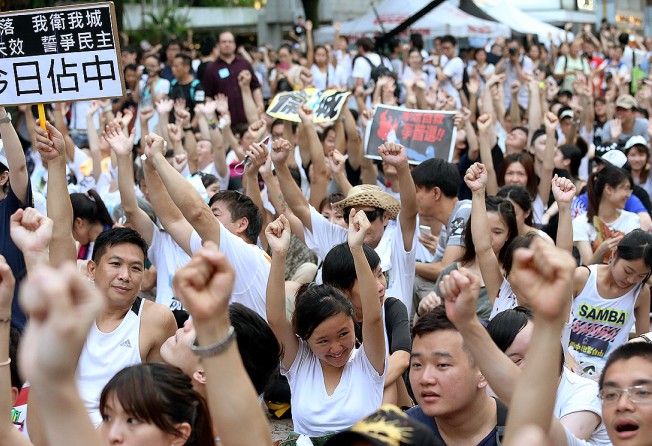
Occupy Central protest 'would need 20,000 participants for effective blockade'
Post study finds pro-democracy group may have to instead target specific junctions if it is to pull off threat of blockading business district

Organisers of the Occupy Central protest will need either to mobilise more than 20,000 protesters or strategically place participants at key junctions if they are to succeed in blockading the city's financial district, the South China Morning Post has found.
Occupy Central organisers have previously said their aim is to rally 10,000 people and use non-violent means in an effort to paralyse the district to pressure authorities here and in Beijing over political reform.
But a Post study found it would take more than 11,000 people just to occupy Chater Road. The number is based on protesters locking arms, as they did in a July 2 sit-in protest on Chater Road. That protest required two adults for each square metre.
Most sit-in protests require 1.67 people per square metre, according to Paul Yip Siu-fai, a University of Hong Kong expert who specialises in crowd counting. But that density leaves large gaps between protesters, making it easy for police to disperse them.
It would take at least 22,000 protesters to form a single, high-density crowd covering Chater Road and a main section of Des Voeux Road Central - two of the main arteries of Central.
Alternatively, organisers could split up the crowd and stage simultaneous sit-ins at critical junctions such as the intersections of Queen's Road Central and Wyndham Street, Connaught Road Central and Pedder Street, and Garden Road and Queen's Road Central.
While a police spokesman said the force would not comment on its operations, a source familiar with the issue said police believed this tactic was the most likely. "Police management has been thinking: if Occupy Central is to go ahead, will it take the same form as the Chater Road [protest]?" the source said.
On that day, a single crowd of some 500 protesters occupied a section of Chater Road. It took police more than five hours to remove the protesters.
The source said police believed the protest may not be limited to Central and were now trying to identify "choking points".
"The police are preparing for the worst: the Cross-Harbour Tunnel, Western Harbour Tunnel or major highways and landmarks may also be their targets," he said. "They will probably have a team of 100 or 200 just to occupy the tramway or a particular junction."
Occupy Central organiser Dr Chan Kin-man said: "If paralysing [Central] is our only aim, just a handful of people blocking the MTR train doors can achieve that. What makes civil disobedience truly powerful is that lots of people are prepared to sacrifice themselves for the common good."